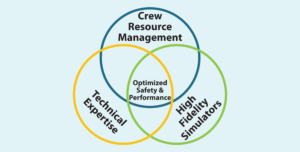Simulator-based training can help crews better prepare for complex MPD operations
By Linda Hsieh, Editor & Publisher
As the drilling industry increasingly deploys managed pressure drilling (MPD) technologies, particularly in the deepwater arena, the potential for simulator-based training to step in and enhance both the safety and efficiency of such operations is also increasing. “When we look at the (knowledge) retention pyramid, the most efficient way for students is hands-on training, where we tie all the theory together with the practical,” Kim Laursen, Head of Well Control Services for Maersk Training, said in a presentation at the 2019 SPE/IADC International Drilling Conference on 7 March in The Hague, The Netherlands.
Even when no new technologies like MPD are involved, the use of high-fidelity drilling simulators provide a safe and cost-efficient environment for drilling crews to practice implementing well control procedures. But when things like MPD come into play, additional value can be gained because deploying MPD often means that processes and procedures – which the crews are already accustomed to follow – are changed. This can have significant impact on how a crew will handle a well control situation during a live operation.
Training for a deepwater MPD operation should also be bespoke because equipment and packages from different manufacturers aren’t always used in the same way. “It’s run a little bit differently from vendor to vendor,” Mr Laursen said. “And we need to talk about roles and responsibilities – who has it and who doesn’t? What does it look like for the driller? And does he know when to say stop?”
Advanced planning for this type of training is essential. “We meet up with the operator or contractor two to three months before, and we figure out what the learning objectives for the training will be,” he explained. “What is it that you want the guys to leave with on Friday? Then we can create the training schedule – what do they need to learn, and how do we achieve this?” Content of the training is based on current capabilities of the crew and whether they’ve had previous experience with MPD, as well as the capabilities of the MPD package.
The training provider then builds multiple scenarios in the simulator, using well data when available to make them as realistic as possible. These scenarios can be more basic, where students just physically practice their procedures and make adjustments as necessary. There can also be more dynamic scenarios, such as high- and low-intensity kicks, losses and ballooning situations.
Unplanned events can also be added during these simulations, which help to get students out of their comfort zones. “On Monday mornings we say to all the students in all of our classes, we are here to fail. If we cannot push you to fail, then I’m not doing my job. If you just do everything successfully, then we’ve wasted a week.”
Mr Laursen recalled a training class where he was leading students to practice drift running – latching on to the BOP in high currents – on a maritime simulator. Before beginning the simulation, the trainers conducted a technical discussion with the crew, then went through the specific procedure step by step. However, once the students began to do the procedure hands-on in the simulator, for various reasons, they did not follow procedures and failed to complete the task after 12 minutes. A debriefing followed.
“If we cannot push you to fail, then I’m not doing my job. If you just do everything successfully, then we’ve wasted a week.”
– Kim Laursen, Maersk Training
“It’s not to point any fingers when we do the debriefing,” Mr Laursen said. “It’s to figure out what went wrong, and that’s one of the real benefits of the simulations, because we can just run it again. We didn’t spend anything but time on it.”

After the debriefing, where the trainers and crew worked together to identify what went wrong, the crew re-tried the scenario in the simulator, and “they did it flawlessly this time around.” They were also able to complete the task in six minutes. In their third try, they managed to get it down to three minutes. “And that’s really the essence of hands-on training. And when we integrate human factors into it, I think we have the whole package for making something that’s valuable and is proven to increase safety and operational efficiency for the crews.” DC
SPE/IADC 194181, “Advanced Drilling Simulators for Well Control Training: Bringing Together People, Procedures and New Technology,” was presented at the 2019 SPE/IADC International Drilling Conference, 5-7 March 2019 in The Hague, The Netherlands.





